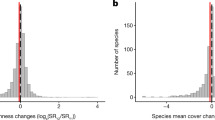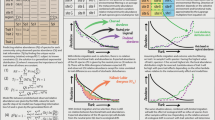Abstract
The neutral model says that the relative abundance of a species is as likely to increase as it is to decrease, because species are ecologically identical1. This hypothesis can be rejected if variance does not increase over time2. We used a more powerful test, based on comparisons among locations, to show that variability stabilizes and, for most species, decreases over thousands of years3. The neutral model also predicts that after a perturbation, relative abundance is as likely to increase as it is to decrease.
This is a preview of subscription content, access via your institution
Access options
Subscribe to this journal
Receive 51 print issues and online access
$199.00 per year
only $3.90 per issue
Buy this article
- Purchase on Springer Link
- Instant access to full article PDF
Prices may be subject to local taxes which are calculated during checkout
Similar content being viewed by others
References
Hubbell, S.P. The Unified Neutral Theory of Biodiversity and Biogeography (Princeton University Press, Princeton, NJ, 2001).
Murdoch, W. W. Ecology 75, 271–287 (1994).
Clark, J. S. & McLachlan, J. S. Nature 423, 635–638 (2003).
Ribbens, E., Silander, J. A. & Pacala, S. W. Ecology 75, 1794–1806 (1994).
Clark, J. S., Macklin, E. & Wood, L. Ecol. Monogr. 68, 213–235 (1998).
Pacala, S. W. et al. Ecol. Monogr. 66, 1–43 (1996).
Keeling, M. J., Mezic, I., Hendry, R. J., McGlade, J. & Rand, D. A. Phil. Trans. R. Soc. Lond. B 352, 1589–1601 (1997).
Ibrahim, K. M., Nichols, R. A. & Hewitt, G. M. Heredity 77, 282–291 (1996).
Le Corre, V., Machon, N., Petit, R. J. & Kremer, A. Genet. Res. 69, 117–125 (1997).
Petit, R. J. et al. Proc. Natl Acad. Sci. USA 94, 9996–10001 (1997).
Author information
Authors and Affiliations
Corresponding author
Rights and permissions
About this article
Cite this article
Clark, J., McLachlan, J. The stability of forest biodiversity. Nature 427, 696–697 (2004). https://doi.org/10.1038/427696b
Issue Date:
DOI: https://doi.org/10.1038/427696b
Comments
By submitting a comment you agree to abide by our Terms and Community Guidelines. If you find something abusive or that does not comply with our terms or guidelines please flag it as inappropriate.



